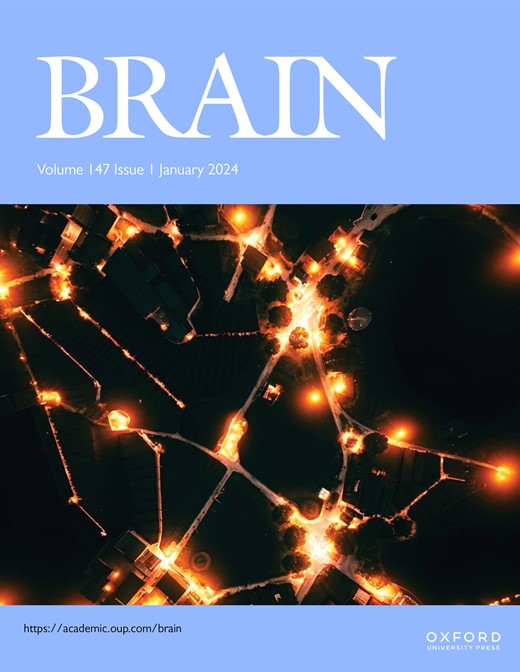内含子FGF14 GAA重复扩增影响多系统萎缩的进展和生存
IF 10.6
1区 医学
Q1 CLINICAL NEUROLOGY
引用次数: 0
摘要
多系统萎缩(MSA)和脊髓小脑性共济失调27B之间存在部分表型重叠,脊髓小脑性共济失调是由FGF14中GAA•TTC内含子重复扩增引起的常染色体显性共济失调。本研究探讨了临床诊断和病理证实的多系统萎缩病例中FGF14 GAA•TTC重复扩增的频率。我们筛选了657例多系统萎缩病例(临床诊断193例,病理确诊464例)和1003例对照。使用远程PCR和双向PCR对FGF14重复位点进行基因分型,并通过靶向长读Oxford Nanopore Technologies测序证实扩增。我们发现19例多系统萎缩病例携带FGF14 GAA≥250扩展(2.89%,n=19/657),显著高于对照组(1.40%,n=12/ 1003) (p=0.04)。长读Oxford Nanopore Technologies测序证实了PCR检测到的重复序列大小和多态性,具有高一致性(Pearson’s r=0.99, p<0.0001)。7例多系统萎缩患者存在致病性FGF14 GAA≥300扩增(病理证实5例,临床诊断2例),12例GAA250-299中间扩增(病理证实6例,临床诊断6例)。以小脑为主和帕金森为主的多系统萎缩病例中FGF14扩增的比例相似。与没有FGF14 GAA扩增的多系统萎缩患者相比,携带FGF14 GAA扩增≥250的多系统萎缩患者表现出严重的步态共济失调、自主神经功能障碍和帕金森病,与MSA表型保持一致,与没有FGF14 GAA扩增的多系统萎缩患者相比,他们更快地发展为跌倒(p=0.03)和经常使用轮椅(p=0.02)。在多系统萎缩患者中,GAA•TTC重复扩增长度与生存呈负相关(r = - 0.67;P =0.02),但与发病年龄无关。因此,对于快速丧失活动能力的多系统萎缩患者,应考虑筛查FGF14 GAA•TTC重复扩增,并在纳入改善疾病的多系统萎缩药物试验时确保完全的诊断准确性。本文章由计算机程序翻译,如有差异,请以英文原文为准。
Intronic FGF14 GAA repeat expansions impact progression and survival in multiple system atrophy
Partial phenotypic overlap has been suggested between multiple system atrophy (MSA) and spinocerebellar ataxia 27B, the autosomal dominant ataxia caused by an intronic GAA•TTC repeat expansion in FGF14. This study investigated the frequency of FGF14 GAA•TTC repeat expansion in clinically diagnosed and pathologically confirmed multiple system atrophy cases. We screened 657 multiple system atrophy cases (193 clinically diagnosed and 464 pathologically confirmed) and 1,003 controls. The FGF14 repeat locus was genotyped using long-range PCR and bidirectional repeat-primed PCRs, and expansions were confirmed with targeted long-read Oxford Nanopore Technologies sequencing. We identified 19 multiple system atrophy cases carrying an FGF14 GAA≥250 expansion (2.89%, n=19/657), a significantly higher frequency than in controls (1.40%, n=12/1,003) (p=0.04). Long-read Oxford Nanopore Technologies sequencing confirmed repeat sizes and polymorphisms detected by PCR, with high concordance (Pearson’s r=0.99, p<0.0001). Seven multiple system atrophy patients had a pathogenic FGF14 GAA≥300 expansion (five pathologically confirmed and two clinically diagnosed) and 12 had intermediate GAA250-299 expansion (six pathologically confirmed and six clinically diagnosed). A similar proportion of cerebellar-predominant and parkinsonism-predominant multiple system atrophy cases had FGF14 expansions. multiple system atrophy patients carrying an FGF14 GAA≥250 expansion exhibited severe gait ataxia, autonomic dysfunction and parkinsonism in keeping with a MSA phenotype, with a faster progression to falls (p=0.03) and regular wheelchair use (p=0.02) compared to the multiple system atrophy cases without FGF14 GAA expansion. The length of the GAA•TTC repeat expansion lengths inversely correlated with survival in multiple system atrophy patients (r = −0.67; p=0.02), but not with age of onset. Therefore, screening for FGF14 GAA•TTC repeat expansion should be considered for multiple system atrophy patients with rapid loss of mobility and for complete diagnostic accuracy at inclusion in disease-modifying multiple system atrophy drug trials.
求助全文
通过发布文献求助,成功后即可免费获取论文全文。
去求助
来源期刊

Brain
医学-临床神经学
CiteScore
20.30
自引率
4.10%
发文量
458
审稿时长
3-6 weeks
期刊介绍:
Brain, a journal focused on clinical neurology and translational neuroscience, has been publishing landmark papers since 1878. The journal aims to expand its scope by including studies that shed light on disease mechanisms and conducting innovative clinical trials for brain disorders. With a wide range of topics covered, the Editorial Board represents the international readership and diverse coverage of the journal. Accepted articles are promptly posted online, typically within a few weeks of acceptance. As of 2022, Brain holds an impressive impact factor of 14.5, according to the Journal Citation Reports.
 求助内容:
求助内容: 应助结果提醒方式:
应助结果提醒方式:


